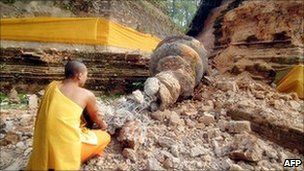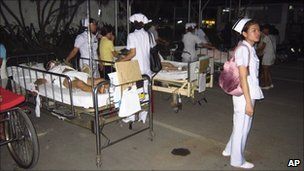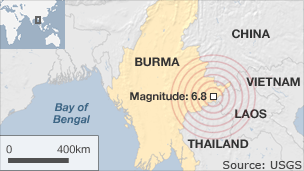
It happened at 1355 GMT on Thursday and was centred about 70 miles (110 km) from the northern Thai city of Chiang Rai, the US Geological Survey said.
It was felt 800km to the south in the Thai capital Bangkok, and in the Vietnamese capital, Hanoi.
The quake was shallow, at a depth of 6.2 miles (10km). There are fears the casualties could be much higher.
State radio in Burma said that 65 people had been killed and 111 injured in the quake.
It said that 244 houses, 14 Buddhist monasteries and nine government buildings were damaged.
The town of Tachileik and surrounding villages in Burma's Shan state appear to have borne the brunt of the earthquake.
Cracks are visible in roads and rice fields have been wrecked by rising silt and water, reports say.
The state-controlled New Light of Myanmar newspaper reported that 15 houses collapsed in the town of Tarlay.
Roads, bridges, hospitals and other buildings have been at least partly damaged.
"We are trying to reach the remote areas," one official said told AFP. Hospital patients and staff outside hospital in Chiang Rai, Thailand - 24 March 2011 Patients in Chiang Rai, Thailand, were evacuated from a hospital following the earthquake

The districts around Kengtung and Tachileik are hilly and remote but an active border trade is carried out between many scattered communities.
The BBC's Rachel Harvey in Bangkok says Burma is ill prepared to deal with natural disasters.
Communication systems and infrastructure are poor and the military government tends to limit the flow of information.
It is likely to take some time before a clear picture of the the disaster emerges, our correspondent says.
Collapsing wall
On the Thai side of the border, paddy fields and temples from Chaengsaen to Mae Sai have been damaged.
In Chiang Rai in northern Thailand, scores of people have been injured and buildings affected.
"We are worried that the area might be hit with stronger quakes. There was another quake at 7am," said Somsri Meethong of the Mae Sai District office, referring to an aftershock.
"I had to run again like last night. What we have seen on TV about Japan added to our fear."
One woman in Thailand's Chiang Rai province, close to the epicentre, was killed when a wall collapsed.
In neighbouring Laos, little damage and no casualties have been reported.
The head of the disaster preparedness for the Red Cross there, Bountheun Menevilay, said the quake was felt strongly in the thinly populated border provinces of Luang Namtha and Bokeo.
Earlier reports suggested there had been two strong earthquakes moments apart in the same area, but the USGS later clarified that there had been just one quake.
Earlier this month, on 11 March, a 5.4 magnitude earthquake struck just north of this area, 225km (140 miles) southwest of Dali in Yunnan, southern China.
That was the same day as the huge 9.0 magnitude quake and tsunami hit Japan; however, Japan is on a different tectonic plate.




Deep in the Heart of South East Asia.